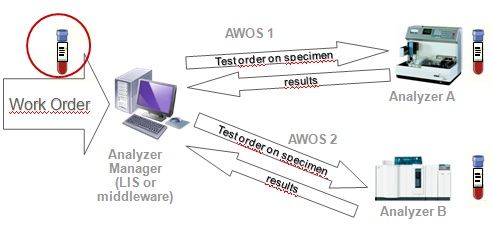Laboratory Analytical Workflow Profile
The LAW profile addresses the exchange of information related to patient and QC test orders & results between IVD testing systems and health informatics systems.
Summary
The purpose of the LAW profile is to improve interoperability between IVD testing systems and health informatics systems by reducing complexity and variability in the exchange of information related to patient and QC test orders and to the result thereof. This profile is thus focused on the analytical workflow in the work area of a clinical laboratory. Its Transactions streamline the scheduling, performance and result reporting of Analytical Work Order Steps (AWOS) between IVD testing systems and healthcare IT systems (LIS or middlewares.
Benefits
<List the key benefits the profile provides (e.g. error reduction, increased throughput) and how they come about (e.g. SWF reduces patient errors due to mistyped demographics at the modality by transfering demographics electronically from the Order Filler). Consider using a bullet list for readability. If possible, identify benefits that help users and vendors make the business case for the profile. More specifically, which of Cost, Safety, Quality or Efficiency is improved by the use of this profile.>
Details
<A few paragraphs, if appropriate, providing more details (mostly in user-speak, not tech-speak) on what the profile does and how it works.>
<If the user might be familiar with the mechanisms used by the profile, you can mention them here. E.g. Evidence Documents is based on DICOM Structured Report (SR) Templates.>
<If the user might have an appreciation for the problems addressed in the profile, you can mention them here, but keep it short. E.g. Mapping HL7 Order fields to DICOM Modality Worklist attributes can be inconsistent in the marketplace, so Scheduled Workflow provides vendors with more detailed instructions.>
Systems Affected
<List (in user terms) the types of systems they might expect to have implemented actors from this profile, e.g. RIS, PACS, HIS, CAD Workstation, etc. and for each, how it would participate.>
- PACS systems may store, manage, and/or display Evidence Documents.
- Display systems may query, retrieve and display Evidence Documents.
- Reporting workstations may retrieve, process and include details from Evidence Documents in reports
Actors & Transactions:
<Insert an actor-transaction diagram, and or list of Content Definitions>
Specification
Profile Status: Trial Implementation
Documents:
last revision from October 2, 2012
Underlying Standards:
<list all the standards on which the profile is based; if possible with links to sources>
See Also
Related Profiles
No profile depends upon LAW. However it is important to stress the repartition between LAW and LDA: LDA covers laboratory devices involved in the pre-analytical and post-analytical workflows. LAW covers laboratory IVD devices involved in the analytical workflow. A middleware system in a laboratory typically plays the role of Automation Manager in LTW and LDA and the role of Analyzer Manager in LAW.
<The following sections can be left out if there is nothing to point to. This is just to show where such information can go.>
Consumer Information
The Profile FAQ Template answers typical questions about what the Profile does. <Replace the link with a link to the actual FAQ page for the Profile>
The Profile Purchasing Template describes considerations when purchasing equipment to deploy this Profile. <Replace the link with a link to the actual Purchasing page for the Profile>
Implementer Information
The Profile Implementation Template provides additional information about implementing this Profile in software. <Replace the link with a link to the actual Implementation page for the Profile>
Reference Articles
<List References (good and bad) (with link if possible) to Journal Articles that mention IHE's work (and hopefully include some analysis). Go ahead, Google: IHE <Profile Name> abstract or Google: IHE <Profile Name> and under the "more" select "Scholar". You might be surprised. >
This page is based on the Profile Overview Template
